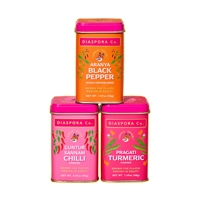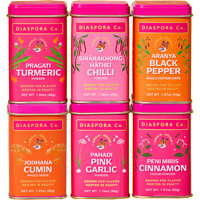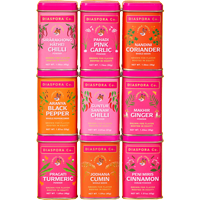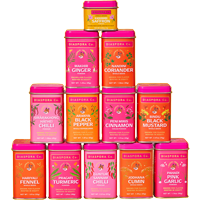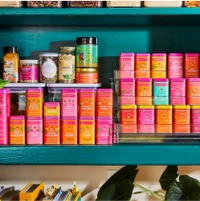Devil’s dung. Seytan tersi. Merde du diable.
In English, Turkish, French and a whole host of other languages, the monikers for asafoetida are so deeply unflattering that you’d wonder why anyone would want to consume or cook with the spice at all. Its most commonly used English name is just as unambiguous. Derived from Farsi and Latin, asafoetida simply translates to “stinking resin.”
So what is asafoetida, and why is it so divisive? At first glance, perungayam in Tamil or hing in Hindi is a nondescript, greyish-yellow spice, commonly sold as solid cubes or a fine powder. But as anyone who has handled even the tiniest smidgen of the spice would attest, its benign appearance belies its potent aroma. (As proof that one person’s odour can be another’s aroma, I have never found the smell of asafoetida offensive).
In fact, asafoetida is a dried exudate—a mixture of gum and resin—that is collected from the taproot of Ferula assafoetida, a plant that is related to the carrot and fennel families.
For a spice that seems to have evoked such a strong olfactory reaction, asafoetida has not just survived since ancient times but also embedded itself deep into the regional kitchens of India. This is where I first became acquainted with it.
If you asked me to describe what perungayam adds to a dish, the answer would be oomph.
When the stridently pungent spice meets hot oil, it mellows and blooms into a scent that has been described as evocative of onions, garlic and leeks. But when I first tasted it in vatha kozhambu, a deeply savory curry with the tongue-curling tartness of tamarind and the insistent bitterness of fenugreek seeds, I didn’t have the vocabulary—or indeed, even the experience—to compare it with those alliums.
Instead, in the recesses of my flavor memory, I remember perungayam adding a novel voluptuousness to my arguably limited palate as a young girl, a real-time understanding of what umami meant, long before I would learn the academic meaning of it.
![]()
According to historical records, asafoetida rose in popularity as a substitute for silphium, an herb that was a favored ingredient among ancient Greek and Roman people, who also used it for its medicinal and contraceptive properties. Researchers say that silphium—which also exuded a gum resin that was mysteriously called “laser”—was so widely harvested during the ancient period that it became one of the earliest known herbs to become extinct.
“Silphium grew only in a region of eastern Libya called Cyrenaica, and ‘Cyrenian silphium’ was widely popular in Greece and Rome from the sixth century BC to the first century of our era, where it was believed to have become extinct,” wrote Chip Rossetti, editorial director of the Library of Arabic Literature translation series at NYU Press, in a paper published in 2009.
Around 328 BC, the armies of Alexander are believed to have stumbled upon Ferula assafoetida growing wild in Afghanistan and Iran. After first mistaking it for silphium, they are said to have accepted it as a suitable substitute.
An unsung yet pivotal part of the early spice trade, asafoetida thus connected the Middle East to medieval Europe. It became enwrapped in the culinary and cultural histories of the Abbasid caliphate, based in Baghdad. The Kitab al-Tabikh (The Book of Recipes), an exhaustive 10th-century Arabic cookbook, is said to contain recipes that utilise every part of the asafoetida plant.
“The resin (al-hiltit) and root (al-mahrut) are occasionally listed as ingredients, but it is the plant’s leaves (al-anjudhan) that seem to have been most popular in Abbasid cuisine: There is an entire chapter devoted to asafoetida-leaf stews (anjudhaniyya)...,” writes Rossetti.
By the 12th century, Indians were also using asafoetida extensively. The Manasollasa, a 12th century book written by King Somesvara II, a south Indian king, made extensive mention of the use of asafoetida. “The most common spice to appear in the Manasollasa is asafoetida, often dissolved in water — a practice still followed in [the states of] Maharashtra and Gujarat,” writes food historian Colleen Taylor Sen in her book Feasts and Fasts: A History of Food in India.
According to Sen, asafoetida was mainly used in lentil-based dishes such as dhosika, “a crepe made from a paste of ground urad dal, black eyed peas or green peas flavoured with asafoetida, cumin, salt and ginger…”, likely a predecessor of the modern day dosa. It was also used in meat dishes such as panchavarni (“five colors”), which was made of cooked sheep intestines.
By the 16th century, asafoetida had become well entrenched in regional Indian cuisines.
“We know from Ain-i-Akbari, an account of life at the court of the sixteenth-century Mughal emperor Akbar written by a high-ranking minister, that it was used in his kitchens,” writes John O’Connell in The Book of Spice: From Anise to Zedoary. While it largely disappeared from European and Middle Eastern cuisines, its uniquely complex flavour and aroma and its potent digestive properties, ensured that asafoetida was never forgotten in India.
In 1563, the Portguese naturalist and physician Garcia de Orta observed the significance of the spice in everyday Indian life. In Colloquies on the Simples and Drugs of India (1563), which is considered the “the first scientific book on oriental spices published in the western world,” da Orta wrote: “You must know that the thing most used throughout India, and in all parts of it, is that Assafetida, as well for medicine as in cookery. A great quantity is used, for every Gentio [Hindu] who is able to get the means of buying it will buy it to flavor his food…”
![]()
Asafoetida’s popularity in India was hastened by the spread of Jainism, a religious philosophy that centered the principle of ahimsa, or nonviolence. In addition to meat and other animal products, its tenets also prohibited the eating of root vegetables, tubers and rhizomes such as potatoes, onions, garlic, carrot and beet, because harvesting these would imply potentially killing the insects and microbes present in the soil.
As Jainism established its presence in a swathe of northwestern and central India, asafoetida became a favored and effective stand-in for the prohibited alliums. Simultaneously, the spice also became ingrained in the culinary customs of other communities with similar dietary proscriptions, such as the south Indian Brahmin community that I belong to. Across the country, small pockets of communities integrated the spice into their culinary oeuvres.
From the Kashmiri Pandits in northern India, who selectively ate meat but avoided onions and garlic, to various communities in western India, who used it in conjunction with meat and alliums, or on its own, hing found a place in the vividly diverse panoply of regional Indian cooking.
In every cuisine that has embraced hing, its versatility is put to a specific use. For instance, the Sindhis—a community that migrated to India from the Sindh province in Pakistan after Partition—use a generous pinch of the spice in Sindhi kadhi, a deeply comforting, tamarind-laced gravy built upon a base of besan (or roasted chickpea flour). Here, the hing is meant to aid digestion. Whereas the Pathare Prabhus, a seafood-loving community from Mumbai, use it as part of Parbhi sambhar masala, a signature blend of spices that is used to flavor seafood, mutton and vegetable dishes.
Driven by its well-established place in these cuisines, India holds the distinction of being the biggest modern consumer of the spice. The country imports large quantities of the unprocessed resin from Afghanistan, Iran, Kazakhstan, Uzbekistan and Tajikistan, which cumulatively produce the lion’s share of the world’s total supply of asafoetida. A clutch of specialist companies in India then process the prized resin and add gum mastic and wheat flour, to make it more malleable and shelf stable, before selling it at a considerable premium.
![]()
Among those who use asafoetida regularly, the provenance and quality of the spice are matters of considerable importance. Purists might insist on procuring compounded asafoetida cubes and powdering it themselves, instead of opting for the more convenient powdered version.
When I asked my mother about her early memories of asafoetida, she recalled how her family went to great lengths to procure the best quality Kandhari hing from Afghanistan. Similarly, some of my earliest, yet most vivid, food memories are of small, meticulously wrapped parcels of hing that my mother ferried back on long train journeys, from her maternal home in north India to Chennai in the south. During the course of this journey of several thousand miles, the pungency of the mummified peringayam invariably engulfed our other belongings. Despite the tut-tuting that followed, the emotional heft of that precious parcel far outweighed its material price.
![]()
This tale could well end here. It could simply be the straightforward story of the lingering popularity of a versatile spice, but for the fact that its continued relevance offers a crucial inlet into a conversation about culinary traditions—and why they ought to be critically examined.
Growing up in a strictly vegetarian household, I probably registered what perungayam brought to many of the dishes that I was regularly exposed to. From pure muscle memory, I can recall the perfumed richness of sambar, a savory vegetable and lentil stew, hemmed together with tamarind and freshly ground spice. I remember how a morsel of perungayam would occasionally pop up between my teeth, and how purposefully I relished its pungency—at first, full-bodied and intense, then mellow and lingering. I also remember how confidently asafoetida asserted its place in a paruppu usli, a soft, crumbled dish made of steamed chana dal and finely chopped vegetables. Asafoetida acted as the exclamation in this otherwise bland and comforting medley, a necessary jolt of flavor.
But what I didn’t know then, and for several more years, was that the culinary rules that dictated how we ate were, in fact, a powerful tool to assert the sociocultural segregations imposed by caste.
An often reviled yet undeniably powerful force in Indian social life, the caste system assigned Hindus at birth to pre-ordained varnas, or castes, separated largely by notions of purity and impurity. As sociologist A.M. Shah defined it in his 2007 paper Purity, Impurity, Untouchability: Then & Now: “Every caste, as a collectivity, was ranked relatively pure or impure vis-à-vis another caste on the basis of mainly its observance of rules of purity / impurity. The concern for purity / impurity decreased as one went down the ladder of hierarchy.”
Placed at the apex of this sliding scale, Brahmins were believed to have been assigned to cerebral and spiritual occupations, which automatically offered them a revered status in everyday life. To safeguard this position of privilege—and to distinguish themselves from others—some Brahmin communities converted to vegetarianism. This included Tamil-speaking Brahmins like my ancestors. (Others, such as Bengali Brahmins in the east and the Saraswat Brahmin community in western India continued to eat certain kinds of meat and seafood).
Onions, garlic and select vegetables were also eschewed by some upper caste communities because they were believed to be aphrodisiacs, and therefore unsuitable to spiritual countenance. In their stead, ingredients such as asafoetida, which packed in flavour within the bounds of these ritualistic norms of eating, rose in importance.
Over time, heightened by the tyrannical stratification imposed by the caste system, the once-porous differences in food customs became more formalized. In this way, asafoetida unwittingly became a signifier of deeper culinary and social divisions. Even though the caste system was officially abolished in 1951, it remains a volatile and violent subject that continues to cause deep fissures in Indian society.
![]()
Against the backdrop of these faultlines, which only seem to have deepened over time, the stranglehold of caste-based food rules needs to be thoroughly examined. The argument that is often wielded as leverage in this debate is the one about “authenticity.”
On the one hand, there is the intangible yet undeniable value of preserving the unique inflections of regional cuisines, often handed down through oral tradition. From this viewpoint, the singularity of a spice or the minutiae of a cooking technique become important cultural artifacts. There is some merit in attempting to capture—through recipes or writing—the ephemeral dimension that hing adds to a hinger kochuri, a flaky, deep-fried Bengali flatbread. Or to a Marathi kokum saar, a digestive drink made of kokum or the dried, tangy fruit of the Garcinia indica tree.
As Saee Koranne-Khandekar, author of the recent cookbook Pangat: A Feast: Food and Lore from Marathi Kitchens, describes it, some dishes “would certainly taste unidimensional without the complexity of [hing]”.
Yet, there is no doubt that present circumstances should also spark a deeper probing of the limitations of authenticity and what we have come to accept as tradition. Dr. Balmurli Natrajan, professor of anthropology at William Paterson University in New Jersey, whose work extensively covers caste and vegetarianism in India, underscores the important point that far from being monoliths, traditions are constantly evolving.
“There is a pull for maintaining tradition among some sections of [communities],” he says. “These are the [people] who continue to insist that an ‘authentic’ Tamil Brahmin meal will not use garlic, but will only use peringayam. However, no tradition is static; they are always changing.”
Even as some strive to contain cuisines within strictly defined boundaries, they are bound to breach them, shaped by the osmotic pull of influences such as migration and travel.
What this means is that even in food cultures where onions, garlic and meat may have once been verboten, such homogeneity of taste is no longer a given. Natrajan illustrates this point with the specific example of the Tamil Brahmin community, which has witnessed a great deal of migration and resultant change.
“Food habits change with travel usually,” Natrajan told me. “What this means is that we can expect that many Tamil Brahmins do like to eat garlic, onions...and even meat. But, because it is not the norm—and norms exert pressure on people to conform to them—it is not easy to get someone from the community to openly admit that they break this norm.”
The downside of not representing this diversity truthfully is that it allows for the unchecked spread of problematic ideas that uphold a skewed power differential, such as the notion that India is a largely vegetarian country. (In reality, vegetarians comprised just 29% of the national average, according to this survey conducted as part of the national census in 2014).
Besides, traditions may be more equitable when we address the discomfiting question of who has the power to define them. This is a question that I asked myself when I began working on this piece. It soon became apparent that my interest in and ability to write about asafoetida comes from the significant caste and class privileges that have allowed a valuable spice to find a guaranteed place in my larder and culinary lexicon.
That thought lingers with me as I bring this story back full circle to my home in Dubai, where I am now based. Having lived outside India for the last six years—and away from my family for more than double that time—my kitchen is a cosmopolitan jumble of ingredients from all over the world. A jar of golden-brown date molasses sits alongside cubes of organic Indian jaggery, and soba noodles are just as often a part of the weekly dinner rotation as sevaiyan or vermicelli. Although my family is still strictly vegetarian, I can no longer claim to be one. Having strayed considerably from the tastes of my childhood, my stash of high-quality asafoetida is no longer imbued with the same emotional heft as that which my mother and aunts ferried back when I was growing up.
It is easy to be lulled into believing that I am free to appreciate a spice for the elementary pleasure of what it brings to a dish. But I know that in reality, there is no ribbon with which to tie up the jagged ends of a critically important discussion on the privilege underwrit even in that simple spice.
This awareness is a sobering one. Yet, tradition somehow tastes better—and sits easier—when it is tempered with it.






